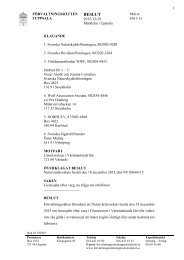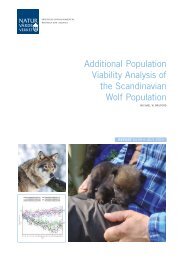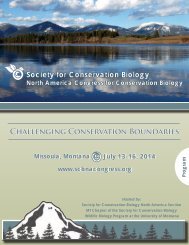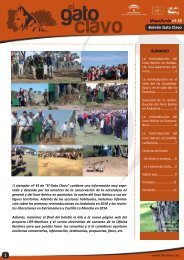1oC3Dbk
1oC3Dbk
1oC3Dbk
You also want an ePaper? Increase the reach of your titles
YUMPU automatically turns print PDFs into web optimized ePapers that Google loves.
development of the Invasive Species indicator within the<br />
Biodiversity Indicators Partnership. The ISSG is a partner in the<br />
IUCN Biodiversity and Protected Area Management (BIOPAMA)<br />
project, and the Island Biodiversity and Invasive Species<br />
Database (IBIS) will be a key contribution to the planned<br />
Regional Observatories. On 6 June 2013, the journal Nature<br />
published an article on the ISSG’s list of “100 of the worst<br />
invasive species”, co-authored by the ISSG Chair and several<br />
ISSG members; the results reported in the article were used by<br />
ISSG and IUCN to post a story on the IUCN website.<br />
Dr Piero Genovesi<br />
Chair, Invasive Species Specialist Group<br />
Korean Plant Specialist Group<br />
The goal of the Korean Plant Specialist Group (KPSG) is to be<br />
an authoritative source of information on the conservation of<br />
Korea’s plants, to play an influential and valued role in national<br />
biodiversity planning and development, to develop national<br />
capacity in plant conservation, to be a mechanism by which<br />
IUCN SSC material and protocols may be introduced to the<br />
Korean conservation community. We pursue all of the above<br />
through active collaboration with relevant partners.<br />
Over the last couple of years, activities of the KPSG have<br />
been limited, as we deliberated over some important points for<br />
The IUCN Red List process. Some KPSG members actively<br />
participated in the National IUCN Red Listing of plant species in<br />
Korea. IUCN Red List projects in Korea have mainly been<br />
supported by the Korea National Arboretum and the National<br />
Institute of Biological Resources under the Ministry of<br />
Environment. The KPSG contributed to the Korean translation of<br />
the IUCN SSC’s Reintroduction Guidelines, which will allow the<br />
wide circulation of this publication to relevant Korean readers.<br />
Dr Kim Yong-Shik<br />
Chair, Korean Plant Specialist Group<br />
Lagomorph Specialist Group<br />
The mission of the Lagomorph Specialist Group (LSG) is to<br />
conduct the best possible conservation science on lagomorphs<br />
and translate this into active management initiatives. We also<br />
aim to educate the public about the important roles played by<br />
lagomorphs in ecosystems, as well as the precarious nature of<br />
some of our highly threatened species.<br />
We are a very diverse and widely distributed Specialist<br />
Group, simply because lagomorphs are found throughout the<br />
Abies koreana. © Kim Yong-Shik<br />
Pygmy Rabbit (Brachylagus idahoensis). © Janet Rachlow<br />
world. Many of our activities are local, such as the pioneering<br />
work conducted by the Pika Fan Club in Japan and the Riverine<br />
Rabbit Programme (now broadened and expanded as the<br />
Drylands Conservation Programme) in the Karoo of South<br />
Africa. In Washington State an active reintroduction program of<br />
the Columbia Basin Pygmy Rabbit has been highly successful.<br />
Other LSG members are tackling issues of how climate change<br />
affects lagomorph populations, and the role played by wildlife<br />
diseases, many of which exert profound influence on<br />
lagomorphs.<br />
A key activity is currently the compilation of materials for an<br />
overarching book: Lagomorphs: The Pikas, Rabbits and Hares<br />
of the World to be published by Johns Hopkins University<br />
Press. Accounts of species for this treatment will also inform<br />
updated IUCN Red List assessments of all lagomorphs. A<br />
precursor step for these activities is our attempt to revisit and<br />
refresh the currently accepted systematics of the Lagomorpha.<br />
New information, including molecular analyses, have informed<br />
us of many potential changes to the traditional systematics of<br />
the taxon. Many of our members are actively engaged in this<br />
systematic work.<br />
Andrew Smith<br />
Chair, Lagomorph Specialist Group<br />
Large Carnivore Initiative for Europe<br />
The Large Carnivore Initiative for Europe (LCIE) is a Thematic<br />
Specialist Group with an ambitious vision “To maintain and<br />
restore, in coexistence with people, viable populations of large<br />
carnivores as an integral part of ecosystems and landscapes<br />
across Europe”. After its chair was confirmed at the end of<br />
2012, we proceeded to integrate several new members<br />
representing all European countries: the group now has 40<br />
members. Our key objectives are to integrate a human-<br />
Large Carnivore Initiative for Europe. © John Linnell<br />
64 IUCN species Annual Report 2013






